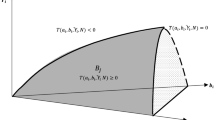Abstract
In a successive Cournot oligopoly, we show the welfare effects of entry in the final goods market with no scale economies but with cost difference between the firms. If the input market is very concentrated, entry in the final goods market increases welfare. If the input market is not very concentrated, entry in the final goods market may reduce welfare if the entrant is moderately cost inefficient. Hence, entry in the final goods market is more desirable if (1) the input market is very concentrated or (2) the cost difference between the incumbents and the entrant is either very small or very large. It follows from our analysis that entry increases the profits of the incumbent final goods producers if their marginal costs are sufficiently lower than the entrant’s marginal cost.
Similar content being viewed by others
References
Abiru M, Nahata B, Raychaudhuri S, Waterson M (1998) Equilibrium structures in vertical oligopoly. J Econ Behav Organ 37: 463–480
Anderson SP, de Palma A, Nesterov Y (1995) Oligopolistic competition and the optimal provision of products. Econometrica 63: 1281–1301
Crettez B, Fagart M-C (2009) Does entry improve welfare? A general equilibrium approach to competition policy. J Econ (in press)
Dhillon A, Petrakis E (2002) A generalised wage rigidity result. Int J Indust Organ 20: 285–311
Dixit A, Stiglitz J (1977) Monopolistic competition and optimum product diversity. Am Econ Rev 67: 297–308
Fudenberg D, Tirole J (2000) Pricing a network good to deter entry. J Indust Econ XLVIII: 373–390
Gans J (2007) Concentration-based merger tests and vertical market structure. J Law Econ 50: 661–680
Ghosh A, Morita A (2007a) Free entry and social efficiency under vertical oligopoly. Rand J Econ 38: 539–552
Ghosh A, Morita A (2007b) Social desirability of free entry: a bilateral oligopoly analysis. Int J Indust Organ 25: 925–934
Ghosh A, Saha S (2007) Excess entry in the absence of scale economies. Econ Theory 30: 575–586
Greenhut ML, Ohta H (1976) Related market conditions and interindustrial mergers. Am Econ Rev 66: 267–277
Ishikawa J, Spencer BJ (1999) Rent-shifting export subsidies with an imported intermediate product. J Int Econ 48: 199–232
Klemperer P (1988) Welfare effects of entry into markets with switching costs. J Indust Econ 27: 159–165
Komiya R (1975) Planning in Japan. In: Bornstein M (eds) Economic planning: east and west. Ballinger, Cambridge
Lahiri S, Ono Y (1988) Helping minor firms reduces welfare. Econ J 98: 1199–1202
Mankiw AG, Whinston MD (1986) Free entry and social inefficiency. RAND J Econ 17: 48–58
Matsushima N (2006) Industry profits and free entry in input markets. Econ Lett 93: 329–336
Mukherjee A (2007a) Entry in a Stackelberg perfect equilibrium. Econ Bull 12(33): 1–6
Mukherjee A (2007b) Note on a generalized wage rigidity result. Econ Bull 10(12): 1–9
Mukherjee A (2009) Excessive entry in a bilateral oligopoly. Econ Bull 29: 199–204
Mukherjee A, Mukherjee S (2008) Excess-entry theorem: the implications of licensing. Manchester Sch 76: 675–689
Naylor RA (2002) The effects of entry in bilateral oligopoly. University of Warwick, Mimeo
Okuno-Fujiwara M, Suzumura K (1993) Symmetric Cournot oligopoly and economic welfare: a synthesis. Econ Theory 3: 43–59
Perry MK (1984) Scale economies, imperfect competition, and public policy. J Indust Econ 32: 313–333
Salinger MA (1988) Vertical mergers and market foreclosure. Q J Econ 103: 345–356
Suzumura K, Kiyono K (1987) Entry barriers and economic welfare. Rev Econ Stud 54: 157–167
Tyagi RK (1999) On the effects of downstream entry. Manage Sci 45: 59–73
von Weizsäcker CC (1980) A welfare analysis of barriers to entry. Bell J Econ 11: 399–420
Williamson O (1968) Economies as an antitrust defense: welfare trade-offs. Am Econ Rev 58: 18–36
Yoshida Y (2000) Third-degree price discrimination in input market. Am Econ Rev 90: 240–246
Author information
Authors and Affiliations
Corresponding author
Rights and permissions
About this article
Cite this article
Mukherjee, A., Broll, U. & Mukherjee, S. The welfare effects of entry: the role of the input market. J Econ 98, 189–201 (2009). https://doi.org/10.1007/s00712-009-0097-4
Received:
Accepted:
Published:
Issue Date:
DOI: https://doi.org/10.1007/s00712-009-0097-4




